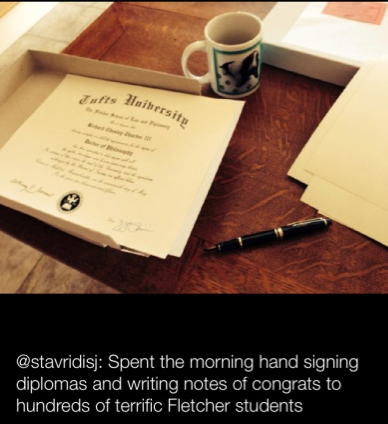I've corresponded with some high profile, exceptionally busy professionals over my 30 year career in the Navy. No one compares to Admiral (Dean) James Stavridis. You can see from his tweet above that he spent the morning hand signing diplomas and writing personal notes of congratulations to hundreds of Fletcher grads. Who does that? Men and women who GENUINELY care about the people around them, that's who! He's a rare breed.
Admiral Stavridis is simply in a class all by himself. But there are some just outside his circle - Honorable Donald H. Rumsfeld, General Stanley McChrystal, VADM Dave Oliver, and LtGen Smith. Few leaders understand the OVERWHELMING power of a personal note.
The flip side of the coin are those leaders who can't/won't/don't make the time for such things. One of the busiest men in the country has proven it can be done. He works his time like the instruments of the best symphony or the talents of the best ballet company in the world. He makes it look too simple.
So, a colleague was asking about when she might expect to get a response from a Flag officer regarding a letter she had written some months ago. I couldn't remember what the protocol was but told her that as a former Flag Aide, 'my' Flag insisted that all correspondence receive a reply within 2 weeks (10 business days). I went in search of a more precise answer and turned to the Secretary of the Navy Correspondence Manual which governs such things as much as they can be governed.
SECNAV Manual M-5216.5
March 2010 states: "Normally, correspondence should be answered within 10 working
days or as prescribed by the immediate superior in command or by the tasking authority for the
response." The timeline tightens considerably when responding to Congress - only 5 days are allowed to reply.
Knowing the state of affairs in today's Flag offices, I am more inclined to tell my colleague not to hold her breath while awaiting a response. Breathe easy - the staff is working it.
Knowing the state of affairs in today's Flag offices, I am more inclined to tell my colleague not to hold her breath while awaiting a response. Breathe easy - the staff is working it.

5 comments:
I can remember COs in our NSGAs not having the time to sign their own correspondence and awards. We had a signature stamp for our CO. If you can't take the time to put your own signature on something, what the hell? Delegate the work to someone that actually cares.
RADM Andy Singer is also very good about note and letter writing.
So this isn't a completely lost art. Yesterday I attended a retirement for a Chief Petty Officer at Fort Meade in the Cryptologic Museum. At the ceremony the retiree was presented a nice handwritten letter (on agency letter head) by the Senior Enlisted Leader (an Army SGM) thanking the Chief and his family for their dedication and service.
RADM Singer is a class act. The last day in Kunia, he drove the CO's sedan up the tunnel and gave us rides to the turnstile. He was a strict vegan, yet he would buy all the sandwiches from fundraising to pass out to the watchstanders. Many tears were shed at his change of command and I was among the fortunate to serve under him.
-DIRSUP Sailor
RADM McFarland was another great note writer. Back in 80's when I was selected as CINCPACFLT SOY, a handwritten note from him meant more than the Navy Achievement Medal I was awarded. When my first child was born, he provided an infant shirt that said, "My Dad is a Sailor" and a note with fatherly advice.
Post a Comment